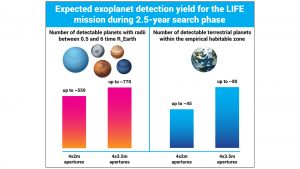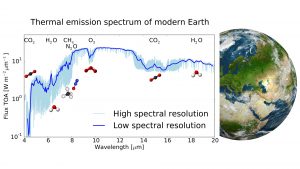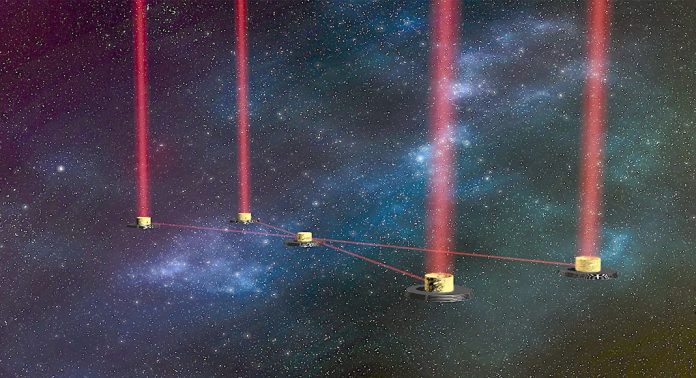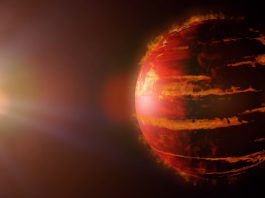LIFE – a future space mission to characterise the atmospheres of terrestrial exoplanets and search for life outside the Solar System.
Are we alone in the Universe? Humankind has been wrestling with this fundamental scientific conundrum for centuries. We now live in a time, with the relevant technologies within reach, where we can start addressing this question empirically. In doing so, we may finally find out if life is indeed unique to our home planet. After the firm establishment of the heliocentric system by Nicolaus Copernicus in the 16th century, putting the Sun – and not the Earth – in the centre of the Solar System, after realising that our Sun was one amongst millions of suns in our Milky Way galaxy, after discovering that our Milky Way was one of countless galaxies in an expanding, isotropic, and homogenous Universe, after the discovery of thousands of exoplanets orbiting nearby stars, life remains the most striking feature that makes Earth and our Solar System stand out in this vast cosmos. Enough motivation to find out if, after all, Earth’s biosphere represents something truly ‘special’.
The heavens full of planets
As of today, more than 4,000 exoplanets have been detected1 displaying a not necessarily expected diversity in masses, radii, and orbital periods. In particular, thanks to NASA’s Kepler mission, we know that, statistically, exoplanets orbit most – if not all – stars. Furthermore, a significant fraction of those exoplanets are terrestrial, i.e., rock-dominated, and orbit within the so-called ‘habitable zone’ of their host stars.2 Here, the temperatures allow in principle for liquid water to exist on their surface – a prerequisite for life as we know it. Equally important is the growing number of exoplanets discovered within 20 parsecs from our Sun as, thanks to their proximity, they are the easiest to investigate in detail. Some of them are also prime candidates for being habitable.3
While ongoing ground- and space-based monitoring programmes are continuing to reveal new discoveries almost on a weekly basis, the wealth of data and number of exoplanetary systems has motivated the exoplanet community to start transitioning from exoplanet discovery to exoplanet characterisation. A primary focus of characterisation projects is to investigate the atmospheric properties of the exoplanets including their composition. Current technology already allows us to reliably detect and investigate the atmospheres of short- and long-period gas giant planets,4,5 and first attempts have been made to detect the atmospheres of small, terrestrial exoplanets.6,7
From discovery to atmospheric characterisation
In the near future, the James Webb Space Telescope (JWST), expected to launch at the end of 2021, might have a chance of investigating a very small number of terrestrial exoplanets orbiting in the habitable zones of nearby M-dwarf stars and confirm the existence of atmospheres.8 In-depth characterisation of atmospheric composition, however, appears to be out of scope.9 Similarly, in the coming 15 years, the next generation of ground-based telescopes, with primary mirrors between 30m to 40m, will also contribute to the detection of terrestrial exoplanets and their characterisation.10,11 But also here the number of objects and the overall characterisation potential will be limited because of the disturbing effects our own atmosphere imposes on ground-based observations.
In order to study a large sample of temperate terrestrial exoplanets and investigate their atmospheres in detail, new dedicated space missions are needed. This is particularly true if the search for habitable planets and atmospheric biosignatures – fingerprints in the atmospheric composition indicating ongoing biological activity on an exoplanet – are main scientific goals. Only from space, sufficient stability, sensitivity, and wavelength coverage is achievable. Also, instead of applying the so-called transit-/eclipse-spectroscopy technique to investigate the exoplanets, the default technique used today, a different observational approach is needed: as their orbits are distributed randomly in the plane of the sky, most exoplanets do not transit in front of their host stars when observed from Earth or space-based telescopes, dramatically limiting the number that can be studied. Only with missions that allow for the direct detection of an exoplanet signal next to that of its bright host star, a sufficiently large number of objects can be studied so that statistical investigations of their properties and the occurrence rate of habitable planets are possible. In order to directly detect an exoplanet, one can chose two different approaches: either one searches for light that the exoplanets reflect from their host star, or one detects the intrinsic thermal radiation the exoplanets emit due to their temperature. The first approach is typically done at optical and near-infrared wavelengths ( ~400-2500 nanometres), and is the focus of mission concept studies carried out by NASA.12,13 The second approach requires observations at mid-infrared wavelengths (~3-20 micrometres) and is the preferred choice for the Large Interferometer For Exoplanets (LIFE) concept, which is discussed in the following.

The LIFE mission
LIFE is an ambitious space mission concept with unparalleled scientific capabilities optimised for the direct detection and atmospheric characterisation of hundreds of exoplanets, dozens of which will be terrestrial, temperate, and possibly hospitable to life as we know it.
LIFE features a formation-flying mid-infrared nulling interferometer consisting of four ‘collector spacecraft’ with 2m to 3.5m apertures flying in a rectangular configuration, and a fifth ‘combiner spacecraft’ flying in the centre of the array (see Fig. 1). Thanks to the four collector spacecraft, LIFE will achieve sufficient sensitivity for the faint signals from exoplanets, and the spatial separation between the spacecraft will provide the required spatial resolution to disentangle the planetary signals from that of the host stars. The light from the collector spacecraft will be sent to the combiner spacecraft where the incoming beams will interfere so that the light from the central star is effectively suppressed (‘nulled’), but photons from nearby, off-axis sources (such as exoplanets) can pass through and can be spectrally dispersed. The baselines between the collector spacecraft will be flexible as they need to be re-arranged for each new target, but a minimum baseline of ~10m and a maximum baseline of ~600m appears sufficient.
The mirrors of the collector spacecraft and the optics of the combiner instrument will operate at a temperature no higher than 40K to supress thermal noise. The goal for the observing wavelength range is three to 20 micrometres and the required spectral resolution is ~50.
To cover the full sky and provide a stable environment for the spacecraft formation, LIFE will be in an orbit at the L2 point. The pointing of the collector telescopes will be primarily in the anti-Sun direction. The nominal mission lifetime will be six years, with up to ~2.5 years for a ‘search phase’ in order to detect exoplanets around hundreds of nearby stars within ~20 parsecs from the Sun and identify the best targets for detailed follow-up observations. The remaining ~3.5 years are devoted to the ‘characterisation phase’ to study a well-selected sub-sample of exoplanets in exquisite detail. The launch of all spacecraft shall be feasible with a single heavy-duty rocket.
The underlying measurement principle for LIFE was conceived in 1978,14 already with the idea in mind to detect exoplanets. And in the early 2000s first concept studies were carried out (ESA/Darwin and NASA/TPF-I), which laid the foundations for LIFE. However, significant progress has been made ever since, both on the scientific and the technology side. This includes, in particular:
- ESA’s Proba-3 mission, planned for launch in 2023, demonstrating autonomous formation flying at a level that exceeds the LIFE requirements;
- ESA’s Herschel mission demonstrating cryogenic technologies and large, lightweight primary mirror sizes for infrared applications;
- Europe’s MIRI instrument for the James Webb Space Telescope demonstrating mid-infrared space technology including detectors;
- Significant progress at the component level, such as cryogenic deformable mirrors, mid-infrared optical fibres and integrated optics; and
- Significant progress on the measuring principle (‘nulling interferometry’) in the lab and from the ground (e.g., with ESO’s VLTI and the Large Binocular Telescope Interferometer LBTI).
In addition, a new experiment was recently started at ETH Zurich with the goal to demonstrate the measuring principle of LIFE at mid-infrared wavelengths and – for the first time – under cryogenic conditions and with flux levels as expected from the astrophysical sources.15 Together, these developments directly feed into the currently ongoing LIFE concept definition, supporting the notion that LIFE’s ultimate scientific goal of searching for life outside the Solar System may indeed be achievable.
What will LIFE deliver?
During its ~2.5-year search phase, LIFE will scan hundreds of stars in the Solar neighbourhood and directly detect hundreds of exoplanets (see Fig. 2).16 Some of these objects are already known today from indirect detection methods, but the vast majority is likely to be new discoveries. Specifically, depending on the observing strategy, LIFE is expected to detect between ~350 and ~550 exoplanets with radii between 0.5 and six times the radius of the Earth for 2m aperture size of the collector spacecraft. This range goes up to ~540 to ~770 exoplanets for 3.5m apertures. In order to maximise the chance of detecting potentially habitable, or inhabited planets, the focus will be on objects with radii between 0.5 and 1.5 Earth radii – because these objects are likely terrestrial – orbiting within the empirical habitable zone of the stars. This region is roughly defined by insolation levels corresponding to between ~0.3 and ~1.7 times the insolation that Earth receives from the Sun.17 For these objects, LIFE is expected to find up to ~45 and ~80 for aperture sizes of 2m and 3.5m, respectively. Already from a single epoch observation, for the majority of these terrestrial, habitable zone planets their radii will be known to better than 20% and their effective temperature to better than 10%.
None of the currently scheduled space missions or ground-based instruments will yield numbers of directly detected exoplanets that are even close to the LIFE numbers mentioned above.
A significant sub-sample of the detected exoplanets will then be scrutinised in detail during the ~3.5-year characterisation phase. Here, the advantage of mid-infrared spectroscopy for atmospheric studies fully plays out. Probing a planet’s thermal emission, gives more robust information about the pressure-temperature structure than reflected light observations. So-called ‘atmospheric windows’, spectral regions without any absorption features from clouds or molecular bands, give direct access to the surface temperature. Finally, the mid-infrared regime offers an unparalleled richness in molecular absorption features from major molecules expected to be present in terrestrial planet atmospheres.18 Importantly, this includes biosignatures such as O3, CH4, and N2O, and also H2O, which is useful for constraining the habitability of a planet (see Fig. 3). According to first quantitative simulations, including most relevant astrophysical noise sources, such as remaining contributions from stellar light and emission from the zodiacal dust cloud, LIFE could detect O3 and CH4 – a strong combinatory biosignature, with no currently known false positives – in an Earth-twin atmosphere located at 10 parsecs within 15 days of observations with 3.5m apertures.
No other mission concept can claim similar capabilities and it is generally believed that the unique power of mid-infrared spectroscopy – and hence a mission like LIFE – will ultimately be needed to robustly assess the habitability of terrestrial exoplanets and identify signs of biological activity beyond the Solar System. It is worth noting that according to recent statistical analyses, the nearest terrestrial habitable zone planet orbiting a K- or G-type star, stars similar to our Sun, is located between four and six parsecs.2 Such an object would require significant less observing time.

The LIFE vision
LIFE is not yet a selected mission; neither is the design of LIFE mature enough that one could start manufacturing and integrating today. In fact, additional R&D efforts will be needed in certain areas (e.g., detector technologies and integrated optics at mid-infrared wavelengths) and successful demonstration of formation flying technology is still pending. However, currently more than 100 people around the world are contributing to the refinement of the science objectives, the definition of science and technical requirements, and the critical assessment of relevant technologies in order to derive a technology development plan. This constantly growing team is convinced that given what is at stake, and what actually appears to be within reach, it is not a question of ‘if’ it is a question of ‘when’ LIFE will be launched. Certainly, LIFE would be a large, ‘flagship’-style astrophysics mission with a price tag possibly similar to recent rover missions to Mars. And whether space agencies or private-public partnerships will support or even lead the implementation of LIFE remains to be seen. But the possible scientific ramifications of LIFE’s investigations may be even more far-reaching than finding evidence of extinct life on Mars. As Carl Sagan once said: “Somewhere, something incredible is waiting to be known.” And LIFE might well be the mission that brings us a significant step closer to finding out where and what it is.
References
- https://exoplanets.nasa.gov
- Bryson, S. et al. (2020). The Astronomical Journal, 161(1), 36. http://doi.org/10.3847/1538-3881/abc418
- Anglada-Escudé, G. et al. (2016). Nature, 536(7617), 1–18. http://doi.org/10.1038/nature19106
- Deming, L. D., & Seager, S. (2017). Journal of Geophysical Research: Planets, 122(1), 53–75. http://doi.org/10.1002/2016JE005155
- Mollière, P. et al. (2020, June 16). ‘Retrieving scattering clouds and disequilibrium chemistry in the atmosphere of HR’ 8799e. arXiv.org
- Swain, M. R., et al. (2021, March 9). ‘Detection of an Atmosphere on a Rocky Exoplanet’. arXiv.org
- de Wit, J. et al. (2018). ‘Atmospheric reconnaissance of the habitable-zone Earth-sized planets orbiting TRAPPIST-1’. Nature Astronomy, 2(3), 214–219. http://doi.org/10.1038/s41550-017-0374-z
- Koll, D. D. B., et al. (2019), The Astrophysical Journal, 886(2), 140. http://doi.org/10.3847/1538-4357/ab4c91
- Krissansen-Totton, J., et al. (2018), The Astronomical Journal, 156(3), 114. http://doi.org/10.3847/1538-3881/aad564
- Brandl, B. et al. (2021). ‘METIS: The Mid-infrared ELT Imager and Spectrograph’. The Messenger, 182, 22–26. http://doi.org/10.18727/0722-6691/5218
- Kasper, M. et al. (2021). ‘PCS — A Roadmap for Exoearth Imaging with the ELT’. The Messenger, 182, 38–43. http://doi.org/10.18727/0722-6691/5221
- LUVOIR Team, T. L. (2019, December), arXiv:1912.06219
- Gaudi, B. S., et al. (2020, January 18), arXiv:2001.06683
- Bracewell, R. N. (1978). Nature, 274(5673), 780. http://doi.org/10.1038/274780a0
- Gheorghe, A. A., et al. (2020). ‘Optical and Infrared Interferometry and Imaging VII’ (Vol. 11446, p. 114462N). International Society for Optics and Photonics http://doi.org/10.1117/12.2576326
- LIFE collaboration, Quanz, S. P., et al. (2021, January 19), arXiv:2101.07500
- Kaltenegger, L. (2017), Annual Reviews of Astronomy and Astrophysics 55(1), 433–485. http://doi.org/10.1146/annurev-astro-082214-122238
- Schwieterman, E. W., et al. (2018), Astrobiology, 18(6), 663–708. http://doi.org/10.1089/ast.2017.1729
Please note, this article will also appear in the sixth edition of our quarterly publication.









